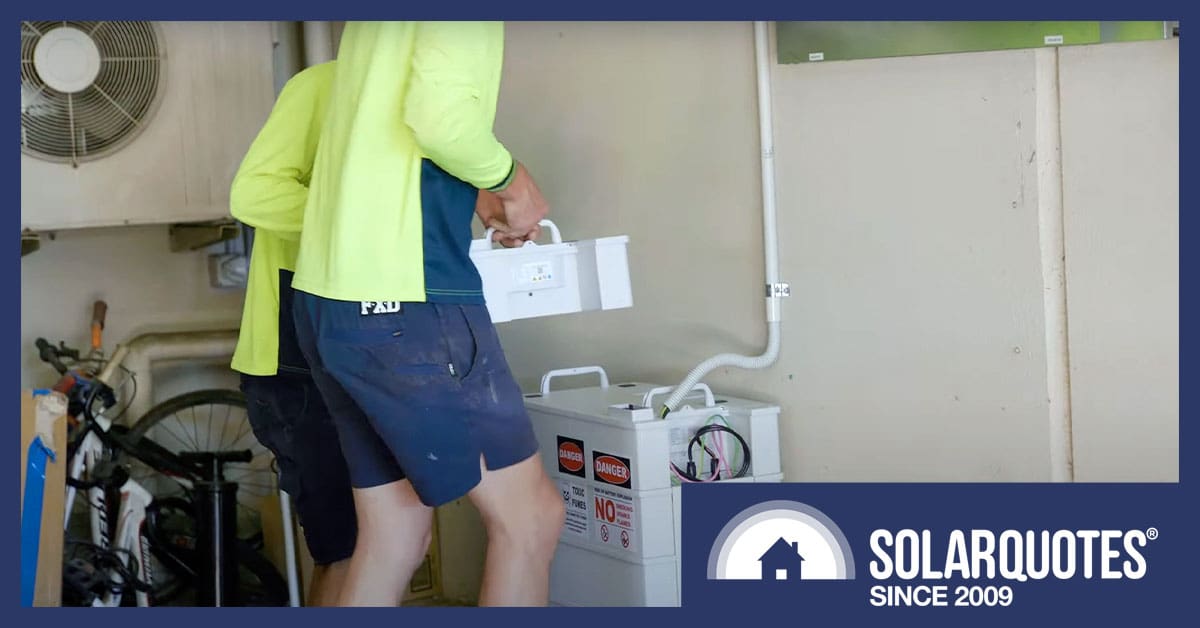
The Tesla Powerwall is renowned for being a shiny white slab of energy storage, but what if you’re willing to sacrifice some style for modularity? Are modular home batteries a better choice?
At SolarQuotes we’re sometimes accused of Tesla bias, but “Powerwall” has become a generic term for solar batteries. Our installers recommend them because they just work, so there’s no escaping the fact we have to measure everything else against them.
The monitoring app is great, the control software is good, backup capacity is robust. By having a single product offering, they’re also marketing a beautifully simple choice for you to make. Buy a Powerwall for 12 grand + installation, or not.
The Advantages of Going Modular
The only problem with Powerwall is if you need more storage, you have to add a second 13.5 kWh Powerwall or nothing. In contrast, modular battery systems present a practical alternative, offering flexibility and scalability that large, monolithic batteries can’t match.
Understanding Battery Types
Batteries come in various shapes and sizes, each with unique advantages. For this article, we can classify them into two categories: large single-unit systems and smaller modular units. Modular batteries, in particular, allow for incremental additions — a perfect solution for those who want to expand their system based on changing needs or budgets.

Magnificent Selectronic & Fronius system with GenZ batteries stacked in a “server rack” style enclosure
A Quick Dive into Battery History
Some of the first lead-acid batteries I installed for off grid systems are likely to be nearing the end of their life at 15 years of age. Others may have already been replaced, twice even, if the system was designed for an electrical demand that subsequently increased.
If the electrical demand rose, you couldn’t just add a few two volt cells. The choice was either to double the size of the battery (by putting a second bank in parallel) or buy a larger set, using larger cells. Then, pay the labour to move a couple of tonnes of lead around and hopefully sell the first set to recoup costs.
Many people hesitated to take this step and ended up destroying expensive batteries in the process.
Overworking lead acid batteries drives them into an early grave. In contrast, today’s lithium batteries are much more adaptable.

532Ah @ C10 means these lead acid beasties are 39kg and 1.064kWh each. When all the links are connected it’s considered a single 25.5kWh battery weighing nearly a tonne
The Shift to Lithium
Lead-acid batteries perform reliably, they offer the plodding dependability of a harnessed guide dog. In contrast, lithium batteries combine the agility of a whippet with the strength of a police K9, but these dogs have to be kept on a short leash because without proper control, they could be a little risky to themselves and the public.
However, with a Battery Management System (BMS) in place, literally harnessed to every cell, lithium batteries perform exceptionally well.
This precise supervision allows for the use of multiple battery units in parallel, unlike lead batteries that require careful attention to manage just two banks. With lithium, you can employ numerous small units; if one unit fails, the others carry on. This setup offers significant redundancy. Plus, you can expand your battery system gradually.
Modular vs. Monolith Batteries
Monolith Systems:
- Typically weigh over 100kg, requiring at least two people for installation or maintenance.
- Can be stacked if space and budget allow.
- Usually include a single gateway or controller, which saves some expense if you do expand later

Enphase is a weird medium. Physically imposing like a monolith battery but weighs 66kg and has a modest 5kWh capacity like a modular unit. Arguably the same footprint as Tesla but less than half the capacity. Image Credit: Nigel Charlesworth
Modular Systems:
- Relatively lightweight, stackable units that one person can manage.
- Start with capacities as small as 2 or 3 kWh.
- Allow for incremental capacity and cost increases.
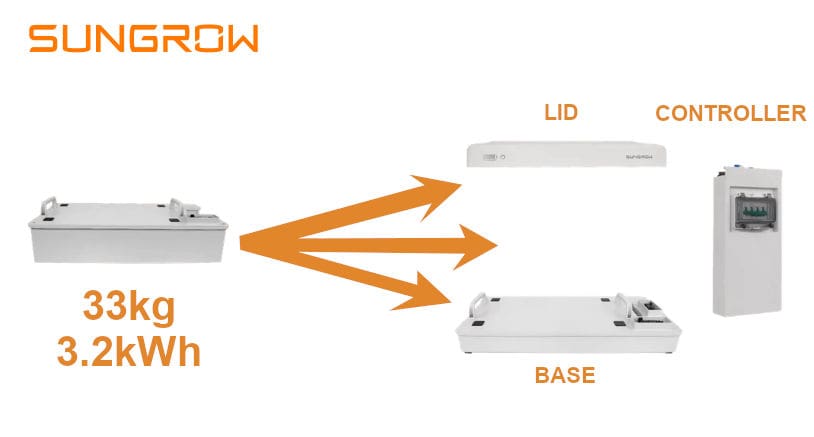
With built in handles, adding batteries is a breeze, but it’s not a DIY job
Finn just shot a video showing how quickly a battery module can be added to a Sungrow stack:
Modular System Traps
Having more redundancy cuts both ways because more connections means more potential points of failure. This is especially true for cheaper batteries with lots of cables to connect. Better units like BYD, Sungrow & Sigen simply plug together automatically when they’re placed in the stack.
While modular systems are versatile, they often require a minimum number of units to function effectively. For instance, the Sungrow SBR can actually be purchased with a “dummy” battery as a spacer to make the hardware designed for three batteries bolt together with only two.
Conversely your system may need several modules to meet peak performance demands. The fine print in many hybrid system brochures will point out that full backup surge capacity requires more than just the minimum sized battery stack.
Some systems allow you to choose the capacity when you buy them, but they’re not expandable after commissioning without affecting warranty.

You’ll need a good installer to translate this
While others, like the BYD B-Box used by Fronius, come in two different flavours. HVS and HVM series cells can’t be mixed and though they are both flexible in building capacity, the HVM can be built into an outright bigger battery.
It pays to know how much you want when you’re finished and how tall the stack will be. Don’t put your batteries directly under the associated inverter because moving things later as the pile grows is a real pain.

The 8 module 22kWh BYD stack is dwarfed by a 60kWh Nissan Leaf.
Random Samples of Modular Battery System Cost
Monoliths
Powerwall 2
- $12,100 for 13.5kWh usable or $896/kWh
- $10,100 for additional 13.5kWh or $748/kWh
- stackable to 10 units
- AC coupled inverter included (but not a solar inverter)
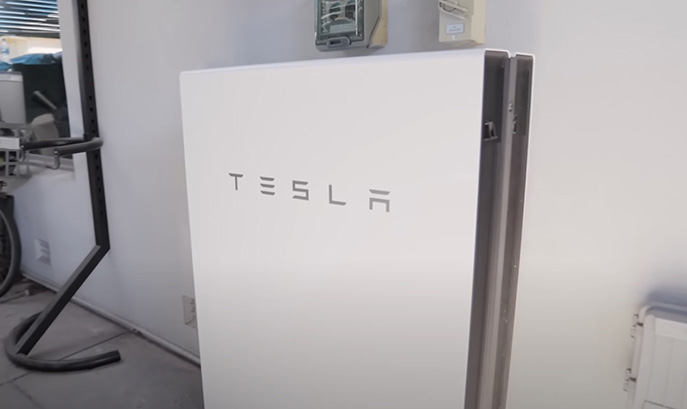
Powerwalls stack together very neatly
Solar Edge Energy Bank Battery
- $13,980 for 10kWh
- $1,398/kWh
- Solar Edge offer many options for inverters
Solar Edge 10kWh battery is a hefty 121kg. image credit Jason Codega
Modular
BYD B-Box Premium HVM Series
- $13,530 for 13.8kWh
- $980/kWh
- Expansion Units
- $2,482 for 2.76kWh
- $899/kWh
- Inverter
- Fronius Primo 5kW Gen24 Plus
- $3835

BYD stacks get taller than this so they shouldn’t be put under the inverter. Image credit Jae Taylor
Goodwe High Voltage LYNX F G2 Battery System
- $8,650 for 12.8kWh including control unit
- $676/kWh
- Expansion Units
- $1,863 for 3.27kWh
- $570/kWh
- Inverter
- GoodWe 5kW Single Phase EH PLUS SERIES Solar Hybrid (Activated)
- $2,544
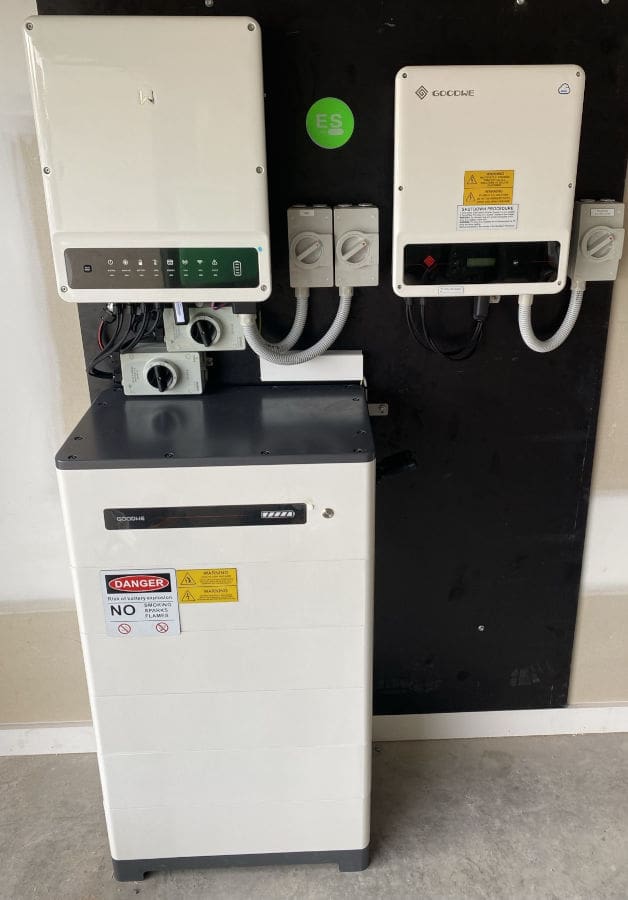
GoodWe 16.38kWh battery with hybrid and standard solar inverters to handle 19.89kW of solar power.
Sungrow SBR Series
- $10,172 for 12.8kWh
- $795/kWh
- Expansion Units
- $2,066 for 3.2kWh
- $645/kWh
- Inverter
- Sungrow SH5.0RS ADA
- $2,887

Sungrow SBR can be stacked to 26kW/h AND use parallel stacks for more storage
Embrace the Modular Approach
Modular batteries offer a dynamic solution for those looking to step into the world of solar energy storage gradually. If you’re planning to upgrade your home’s energy system or are new to solar power, consider the flexibility and scalability of modular batteries. If nothing else, they can unlock greater value from your solar by allowing you to bypass the 133% rule.
Start small, think big, and take control of your energy future in bite-sized chunks. SolarQuotes can help find you the right advice and a great installer.

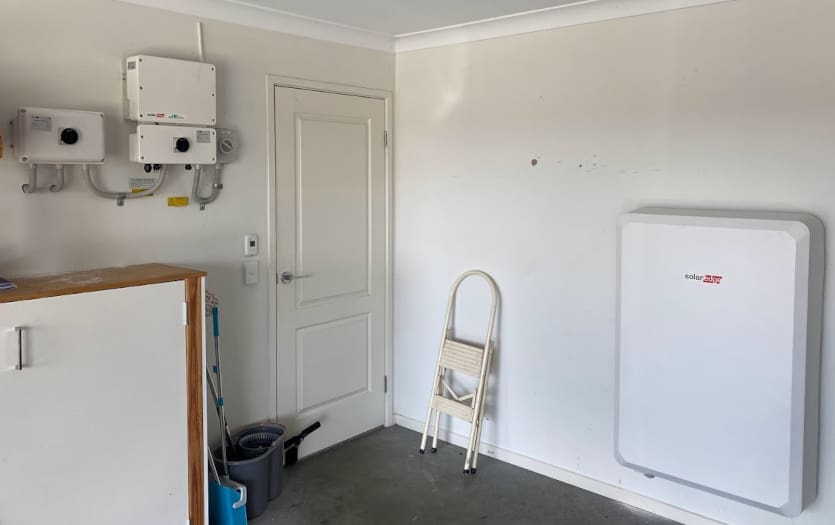
 RSS - Posts
RSS - Posts



Good article thanks. It would have been nice if you’d included the new Sungrow batteries rather than the ones that have just been replaced but that’s easy enough for people to look up for themselves.
Battery prices are not moving! We have the Sungrow 9.6 KWh unit, not because the price is good, but because of the backup system. It comes with the battery, not an extra option, and as Finn has demonstrated in one of his videos, it works great! Even the computer stays on.
What we found is that one of the smart lights switched on when a black out happened, but that’s good, we know we had one!
Sungrow hybrid changeover speed is amazing , I suggested Sungrow to my son when i found out my brand new Fronius gen24 does not UPS. Now saving up for a utility Hybrid inverter that can work as a proper backup.
Lyle, I am not sure what you mean that gen 24 doesn’t do UPS. As far as I known Fronius Gen 24 is one of the few inverters that works when the Grid is down. What I mean is when the Grid is down during the day can provide solar to the house and charge the battery at the same time. I am extremely happy with my Gen24/ BYD system. Yes, it takes a few second for change over but I understand that this is to protect the appliances and the system. I would rather have a few seconds delay than to to rely only on the battery at bright sunny day.
Hi Lyle,
You’ll actaully find that true UPS capacity isn’t offered by any hybrid solar inverter.
Series connected Sungrow, GoodWe et al are fast to change over but if the battery is close to fully charged and the inverter is exporting to the grid when there’s an outage, they will shut down and restart like a Fronius, SolarEdge or other parallel connected machine.
The problem with seamless changeover and whole home backup is the possibility nobody notices, and they run their battery flat with air conditioning or overload the system with a stove.
In a perfect world they should get seamless transition along with a notification via their integrated app on their phone yeah?
I can’t believe this isn’t already being done.
I think it is. 😂
Tesla !
We upgraded our 7kW Winacio solar panels in 2018 with Fronius inverter to 11.5kW with another Fronius inverter and a Selectronic Inverter. Plus added10kWh BYD LiFePO battery consisting of 4×2.5kWh modules in a cabinet.
We live in a bush fire risk area and have a house sprinkler system run with electric water pumps. We are grid connected and usually get about $50-$150 payment from our energy provider. We have security of power in an emergency and get cash back from our grid connection. Also we are usually exporting power most days (last couple with big rain event we imported power to keep our battery topped up (this yrs so far Mid May imported 144kWh and exported 2.81MWh)
We are very pleased with our BYD LiFePO modular battery and our inverters.
One thing we like about the Selectronics is when grid power goes transition to battery is almost seamless. The Selctronic inverter switches in 65ms, we have had blackouts and not know until a neighbour rang during a night blackout and asked why our lights were on.
The Sungrow switchover is 10ms which is seamless. Fronius have fallen badly behind in this area and need to lift their game imho.
Response to Nigel
We put this system together based on very professional advice in 2018 and we are very pleased with its performance. However, I would hope solar/battery/inverter technology has improved significantly since 2018.
The equipment supplied by our installer was of good quality, installed professionally and has performed well. I am sure the technology mix would be different today. We in particular are very pleased with the Selectronics inverter and BYD LiFePO battery bank.
The Fronius inverters from 2018 have so far performed well. We have no cause for complaint on the 6 year old hardware.
A very solid decision in 2018. I just wouldn’t do the same thing in 2024.
What would you recommend for 2024.
We may be moving house in the next year or so we plan to contact the same installer as we are very happy with their work for our new system.
We would look at least 12kW of solar and most likely 20kWh of LiFePO BYD battery with Selectronics inverter the rest we would leave up to our trusted installer. However, happy to consider other options, but would be leaning strongly toward BYD LiFePO battery.
What would I recommend for 2024?
It really comes down to exactly what you want it for and how good you want it for the price.
The new Sungrow SBH200 – 400 battery series comes at between a 4 module stack of 20 kWh and an 8 module stack of 40 kWh and delivers up to 50A continuously at a maximum discharge power exceeding 25 kW with a 10 ms switchover. Combined with one of the new SH15/20/25T 3-phase hybrid inverters or equivalent single-phase inverters, the price to performance value and simplicity for a grid-tied system is compelling.
Of course, if you want the absolute best and don’t care about the price, especially if you put 3-phase on at your new place, then get an upgrade of the system you already have. Multiple Fronius inverters and either a single Selectronic SP Pro Series 2i inverter or three of them if you have three-phase, and a BYD battery. There’s a reason why a single 5 kW Selectronic inverter costs $6,500 and due to the size of the induction coil inside it’s illegal to connect to the grid. Nothing beats it.
Word.
Selectronic is the best bar none and can in fact be grid connected but it’s not allowed to export from the DC side sadly.
https://www.solarquotes.com.au/blog/selectronic-sp-pro/
Thanks Nigel sounds good will try to keep your ideas in mind when we work out what we are doing when we move.
Another facet is local API control over the battery.
I understand that the Tesla Powerwall does not make a local API available for the customer to use to control the battery. This means that you have to rely on some cloud service to do this like Tesla’s VPP or some other supplier’s VPP service or the less intelligent self consumption mode.
So this leave the profits that can be made from the wholesale market to the VPP service provider and these profits can be significant.
Also this isolates the battery and solar system from the rest of the household loads when it comes to home automation.
When I charge the car or heat water or run the washing machine or whatever I’d prefer that be done within the same control system as that which controls the battery and solar system.
So which of these batteries can be locally managed by the owner?
The only issue I have with the modular battery is when the time comes to add new modules the Installers charge arm and a leg..For adding 2 extra modules on my BYD battery, $ 1,300 for installation….I wish I was an electrician…
Hi Ilian, if it helps at all, we’re getting 4 extra modules for our BYD (existing 4) and the quote is pretty much 4 times the approximate price Anthony has quoted above (the labour isn’t separated out, it’s a bundled price).
Is this the case with Sungrow when the grid goes down when the home is powered from PV at the time [there is no interruption in that case], ie., when the PV power stops and the change over to battery while the grid is still out?
Can attest to the fact that there is no interruption to supply when being powered by PVs. It happened and didnt know it until received sms from Energex alerting to when it would come back on. And, as someone else has noted, the smart light turns on of the power to them goes off and comes back on again – they didnt.
When are we going to just get some proper size batteries at a fraction of the cost? Why all the discussion about a single 13kW battery, or 5 x 3kW modules when we should have 50-80kW home batteries and never have to think about it again?
I was reading an article from the NRMA that at the start of the year the wholesale cost of a 50kW EV battery from China was just $9,500. How about sticking that battery in a residential casing with some software and selling it for $20,000?
So if I can’t use my EV easily just yet for V2H or V2G, and batteries are still small and vastly overpriced, I guess I will just continue the waiting game! Which is a shame, because it’s been such a missed opportunity in the last few years.
Hi Brenton,
Did you see this post? Some people are just getting on with it despite the regulations & lack of products.
https://www.solarquotes.com.au/blog/hoem-review/
Yes I did thanks Anthony – interesting product. Still just a small stop-gap though, relying on your car having a V2L and not offering much in terms of bi-directional charging, large power outputs, integration with the rest of your home etc. So it’s not really what i was referring to which is the ridiculously expensive cost of home batteries vs car batteries and the slow progress of V2H and V2G which has been promised for years and still feels like it years away.
Must be a lot of pressure from electricity generators and networks to keep the status quo as they know they’re going to lose massive profits as soon as people are able to generate, store and then use their own power from their roof tops and effectively cut them out of the equation. Or worse still, have their large batteries connected and profit from the open market in times where there are additional profits to be made.
Similarly for Tesla – why would they change their battery offerings when it’s one of the most profitable products they produce?!? Sad really.
Yes indeed. The risk is that without a local retailer you get no practical or warranty support- a fairly big gamble. An even bigger question is why we can’t use vehicle batteries either personally or as grid assets, because they are much bigger than household batteries and our cars spend a lot of time in the garage doing nothing. V2H/V2G now!
A good demonstration of how ridiculous it all is, is that you could install 81 kWh of Tesla Powerwalls (ie. 6 of them) for $62,600 based on the prices in the article above…
OR
you could buy a white Tesla LR on the website right now in the ACT for a little over $70,000… – Which just happens to come with a 82 kWh battery.
So basically you could get about the same amount of power for about the same price, but the 2nd option comes with a FREE TESLA car as well!
Similarly Brenton,
A BYD or Kia branded battery comes with a free car and a camping generator to power your house in a blackout!
Unfortunately the usage pattern for a car and a house are very different. Not sure if V2H will ever be a thing…
Of course it will. They’re super compatible. Most people have their car at home during the evening, which is when the sun is no longer shining and people with solar are then reverting to grid energy. To make use of the power in your car’s battery is a no-brainer.
Some people will have the option to charge their car at work, and bring it home to power their house. Others could charge up on off peak hours overnight (or on weekends from solar) and use their car’s power during the peak hours of early evening, and morning.
My situation is likely to be even more compatible. I work from home and so my car is here 95%+ of the week. It can suck up solar all day, and pump it back into the house every night. Too easy! Just need EV manufacturers, Inverter manufacturers and electricity retailers to lift their game a little faster than the last few years and it’ll happen.
Hi Brenton,
Something tells me the incumbent industries aren’t keen to self immolate… :/
But surely there has to be someone in the solar and/or battery industry that sees this wide opening, and decides to drive a truck through it?!? It’s big enough after all.
Perhaps someone with sufficient knowledge, contacts and desire might pursue that 50kW home battery for about $20k installed?!?
New direction for those at Soar Quotes perhaps? Make a product that everyone wants? I’ll sign up as your first customer 🙂
I believe because most installers basically double the price of the battery (if not triple) just from installation costs. When the battery is out there with public pricing (and they obviously get it wholesale so cheaper again) then it doubles installed we have a major problem and someone is getting rich.
I’ve called for so many quotes and all the installers have batteries (or even multiple systems) installed because it’s a no brainer for them at the prices they can get them, yet it is double to triple for us making it unaffordable for the masses.
But I would 100% agree with you, even at the prices you mentioned people would double their money (maybe a bit less because of freight by not by much) cover install easily in that price as well and fix the country’s issue with some of the developed worlds most expensive electricity.
I’d happily pay 20k for 50kW, so would most people.
Ozbloke – I know what installers pay for the batteries – your analysis is way out. They charge a modest margin on the battery and then an installation cost which covers their overheads, balance of system, and profit.
You didn’t mention that Solaredge is the only Battery that has an inbuilt fire extinguisher. Should thermal runaway start these systems and its inbuilt “fire extinguisher” might be the best thing.
I get everyone has a bias towards certain brands. I happen to think Solaredge is a great product.
That’s because they’ve used the wrong battery chemistry!!!
what chemistry should they have been using ?
LFP
I have a strong opinion due to cost and longevity, the ability to charge to 100% without stressing battery, LiFePO is a better battery chemistry for many applications.
Li-ion is good for applications where weight important, but only charging to 80% an issue.
Newer battery chemistries should address these issues in next few years.
Hi,
How about Everyready Batteries. I have 10.4kw which reach 80%+capacity on even cloudy days by 11am here on the mid-north coast of NSW. Great support from the Solar Battery Group and am thinking of adding another 10kw because of their half-price 0ffer. What’s not to like. How about a review of these batteries.
Regards
Anthony Bennett (an older one)
Hi Anthony,
Just curious are the Solar Battery Group a crowd who do letterbox drops, cold calls or door-to-door sales? We generally shy away from that type of operation but if you have soem feedback feel free to put up a review.
https://www.solarquotes.com.au/solar-reviews/
I may be wrong on this but I was quoted around $1000 for a firmware upgrade on my Fronius Gen 24 inverter to allow for a BYD battery to be connected to it. Apparently out of the box they are not battery ready. As a beside, here in Qld we were being offered a rebate on the purchase of a battery. The corresponding battery price rise negated this.
Yes that’s about right – $1,000 to enable the battery function in a Gen 24. Fronius claims it makes the upfront price of the Gen 24 about $1000 cheaper than it would otherwise be.
Has anyone integrated a modular battery system to a solarEdge inverter ?
Not that I’m aware David